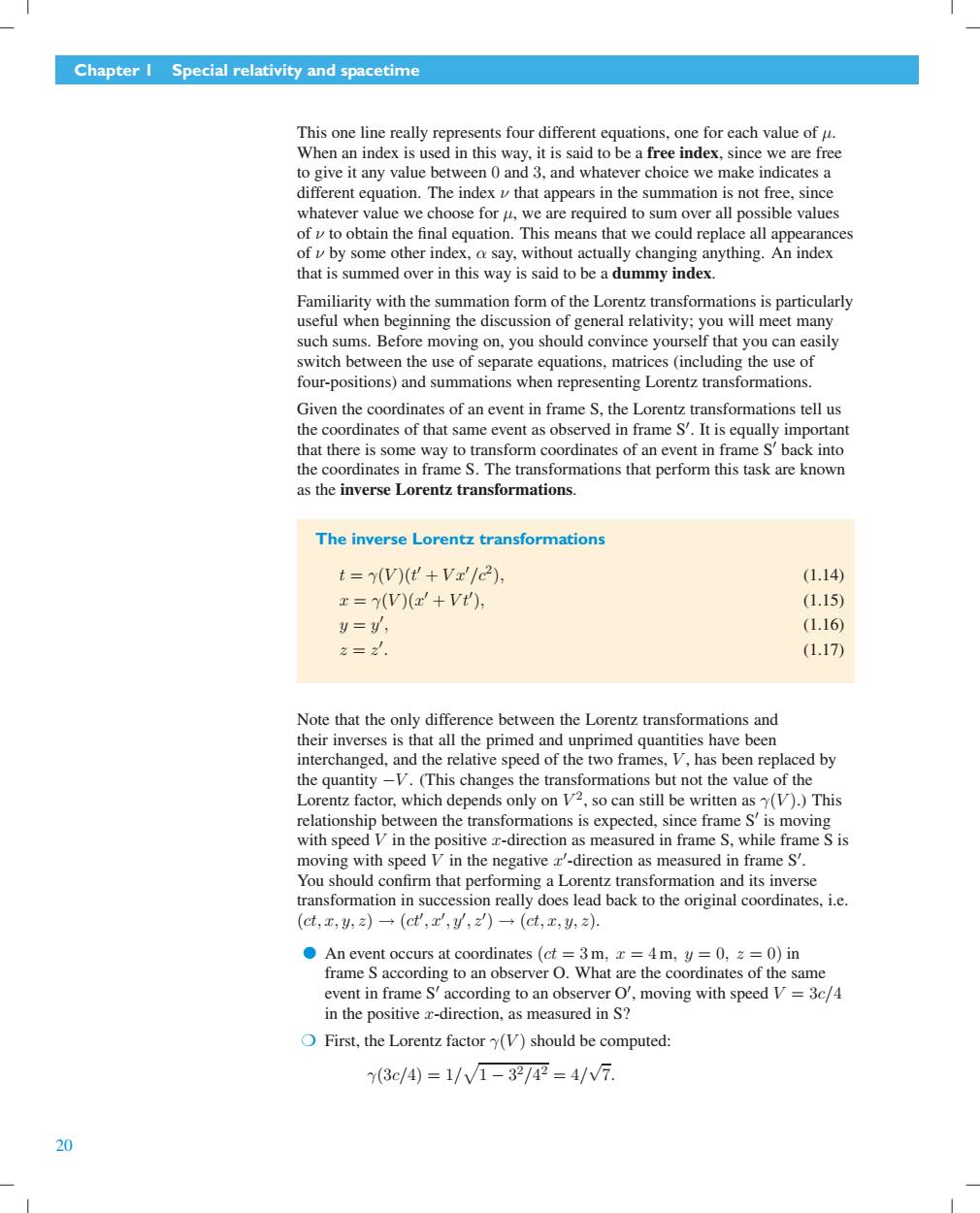正在加载图片...

Chapter I Special relativity and spacetime This one line really represents four different equations,one for each value of u. When an index is used in this way,it is said to be a free index,since we are free to give it any value between 0 and 3,and whatever choice we make indicates a different equation.The index v that appears in the summation is not free,since whatever value we choose for u,we are required to sum over all possible values of v to obtain the final equation.This means that we could replace all appearances of v by some other index,a say,without actually changing anything.An index that is summed over in this way is said to be a dummy index. Familiarity with the summation form of the Lorentz transformations is particularly useful when beginning the discussion of general relativity;you will meet many such sums.Before moving on,you should convince yourself that you can easily switch between the use of separate equations,matrices (including the use of four-positions)and summations when representing Lorentz transformations. Given the coordinates of an event in frame S,the Lorentz transformations tell us the coordinates of that same event as observed in frame S'.It is equally important that there is some way to transform coordinates of an event in frame S'back into the coordinates in frame S.The transformations that perform this task are known as the inverse Lorentz transformations. The inverse Lorentz transformations t=y(V)(t+Vz'/c2). (1.14) x=Y(V)(z'+Vt'), (1.15) y=y, (1.16) 2=d. (1.17) Note that the only difference between the Lorentz transformations and their inverses is that all the primed and unprimed quantities have been interchanged,and the relative speed of the two frames,V,has been replaced by the quantity-V.(This changes the transformations but not the value of the Lorentz factor,which depends only on V2,so can still be written as y(V).)This relationship between the transformations is expected,since frame S'is moving with speed V in the positive r-direction as measured in frame S,while frame S is moving with speed V in the negative a'-direction as measured in frame S'. You should confirm that performing a Lorentz transformation and its inverse transformation in succession really does lead back to the original coordinates,i.e. (ct,c,,2)→(ct,x,,)→(ct,x,y,z) An event occurs at coordinates (ct =3m,x=4m,y=0,z=0)in frame S according to an observer O.What are the coordinates of the same event in frame S'according to an observer O',moving with speed V =3c/4 in the positive x-direction,as measured in S? First,the Lorentz factor (V)should be computed: y(3c/4)=1/V1-32/42=4/W7. 20Chapter 1 Special relativity and spacetime This one line really represents four different equations, one for each value of µ. When an index is used in this way, it is said to be a free index, since we are free to give it any value between 0 and 3, and whatever choice we make indicates a different equation. The index ν that appears in the summation is not free, since whatever value we choose for µ, we are required to sum over all possible values of ν to obtain the final equation. This means that we could replace all appearances of ν by some other index, α say, without actually changing anything. An index that is summed over in this way is said to be a dummy index. Familiarity with the summation form of the Lorentz transformations is particularly useful when beginning the discussion of general relativity; you will meet many such sums. Before moving on, you should convince yourself that you can easily switch between the use of separate equations, matrices (including the use of four-positions) and summations when representing Lorentz transformations. Given the coordinates of an event in frame S, the Lorentz transformations tell us the coordinates of that same event as observed in frame S % . It is equally important that there is some way to transform coordinates of an event in frame S % back into the coordinates in frame S. The transformations that perform this task are known as the inverse Lorentz transformations. The inverse Lorentz transformations t = γ(V )(t % + V x% /c2 ), (1.14) x = γ(V )(x % + V t% ), (1.15) y = y % , (1.16) z = z % . (1.17) Note that the only difference between the Lorentz transformations and their inverses is that all the primed and unprimed quantities have been interchanged, and the relative speed of the two frames, V , has been replaced by the quantity −V . (This changes the transformations but not the value of the Lorentz factor, which depends only on V 2 , so can still be written as γ(V ).) This relationship between the transformations is expected, since frame S % is moving with speed V in the positive x-direction as measured in frame S, while frame S is moving with speed V in the negative x % -direction as measured in frame S % . You should confirm that performing a Lorentz transformation and its inverse transformation in succession really does lead back to the original coordinates, i.e. (ct, x, y, z) → (ct% , x% , y% , z% ) → (ct, x, y, z). ● An event occurs at coordinates (ct = 3 m, x = 4 m, y = 0, z = 0) in frame S according to an observer O. What are the coordinates of the same event in frame S % according to an observer O% , moving with speed V = 3c/4 in the positive x-direction, as measured in S? ❍ First, the Lorentz factor γ(V ) should be computed: γ(3c/4) = 1/ - 1 − 3 2/4 2 = 4/ √ 7. 20